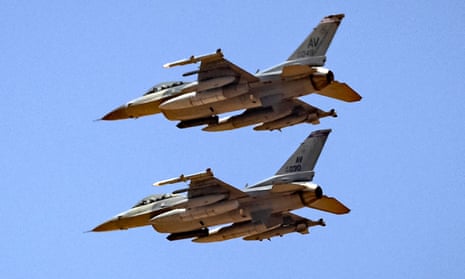What is the F-16?
The F-16 Fighting Falcon is a lightweight fighter aircraft that was initially designed in the 1970s. It first went into service in 1979, and was used heavily by the US Air Force in both Iraq wars and in Afghanistan.
Originally built by the US in a consortium with Belgium, Denmark, the Netherlands and Norway, the jet, which can travel twice the speed of sound, became one of the most popular military aircraft of all time and remains in wide use. Lockheed Martin, the US manufacturer, says there are more than 3,000 F-16s in service in 25 countries.
Today, it has been superseded by the F-35, but it is still being manufactured for sale by Lockheed in South Carolina. That’s because it is cheaper – costing in the tens of millions – and because the US does not always give export permission for the more modern jet.
Why does Ukraine want them?
Ukraine had a small air force of Soviet-standard jets at the start of the war, amounting to about 120 combat-capable aircraft, according to the IISS thinktank. That number has dwindled as the war has continued, though – remarkably, given the number of Russian aircraft and air defences – experts say Ukraine retains a limited air capability. But as time goes on, its air force will need to be replenished.
A curious feature of the Ukraine war has been its relatively limited use of air power. Russia’s anti-aircraft defences are considered effective, and Moscow has been reluctant to risk its own air force beyond the frontline, as it also wants to minimise losses. The former US Air Force general Philip Breedlove has described the air situation as one of “mutual denial”.
Nevertheless, Kyiv hoped squadrons of fast jets could be used to support a breakthrough, or least help blunt a major Russian attack.
What is the current thinking in the west?
Ukraine began a high-profile lobbying campaign for the fighter jets in January, almost immediately after Germany and the US said they would supply their own tanks to Ukraine for the first time.
France, which makes its own combat jets, seemed open to the idea from the beginning. President Emmanuel Macron said their supply was not taboo, as long it could not be deemed escalatory and they were not used to target Russian soil.
However, it is the White House position that is critical, because the US has control over the jets’ re-export and no nation wants to be out of step with Washington, given concerns about any possible Russian retaliation.
The US attitude has evolved rapidly, from a firm no from Joe Biden in late January, to western briefings on 19 May that the US will back a joint international effort to train Ukrainian pilots to fly F-16 and other modern fighter jets. The decision does not necessarily mean F-16s and other fighter jets will be supplied immediately on the completion of training. Rather, it will give the US and its allies the capability to deliver planes at short notice.
The change of mind echoes conversations over the supply of other munitions, such as tanks.
What about training and maintenance?
Western officials said on 19 May that training will begin in the next few weeks at an unspecified site in Europe and will take a few months to complete.
Learning to fly the F-16s is a job for experienced pilots, and they would have to be taken out of the war to train. Ukraine is said to have identified 50 pilots who it would hope to train immediately.
Estimates vary, but it could take four to six months to train pilots to a combat proficiency. The requirements go beyond pilots too. “An aircraft has to come with a weapons package, ground crew and support,” said Douglas Barrie, of the IISS thinktank, meaning Ukraine will need spare personnel and to train its own cadre of engineers. It is more complicated than learning how to use a western tank.
Can F-16s make the hoped-for difference on the battlefield?
In part, it is a question of how many F-16s Ukraine could obtain. The country’s air force has boldly asked for 200, a number that even a generous west may be reluctant to provide in the first instance.
Justin Bronk, an air analyst with the Rusi thinktank, cautioned that the strength of the Russian air defences meant traditional close air support – bombing enemy positions – was hard to achieve because planes were forced to fly low to evade detection. As a result, their advantages in terms of weapons and radar may only be incremental.
“Western fighters with stand-off weapons would offer Ukraine an improved capability to destroy fixed Russian targets near the frontlines from a safer distance,” he tweeted, but “they would be adding to existing strike options like Himars [rocket artillery] and drawing from limited stockpiles”.
